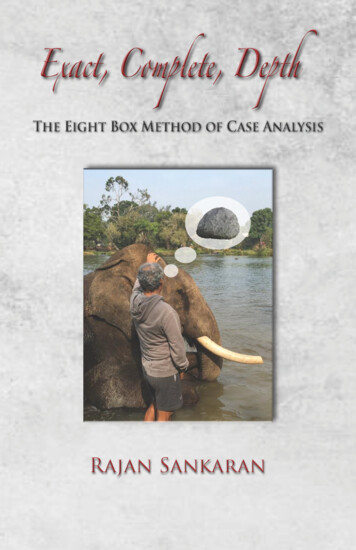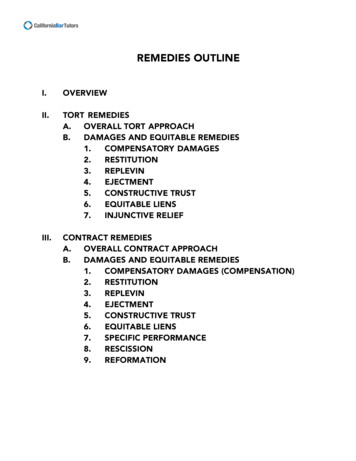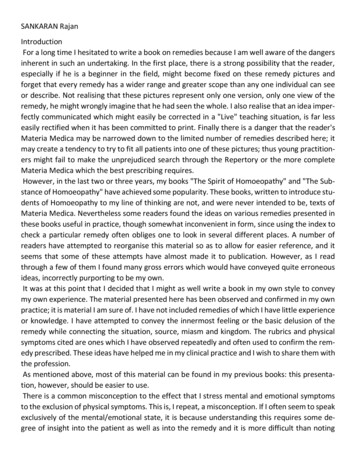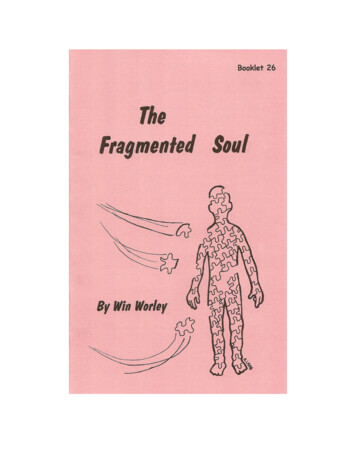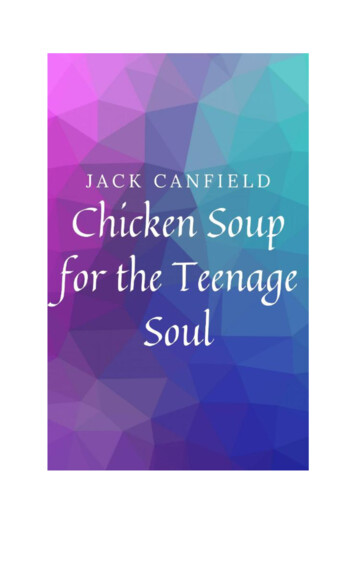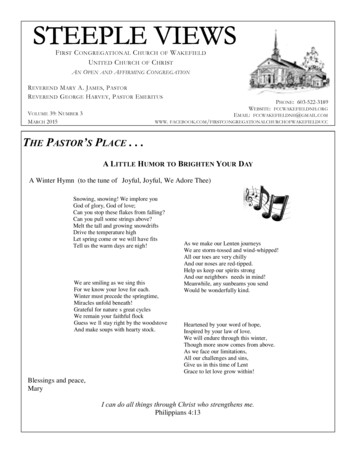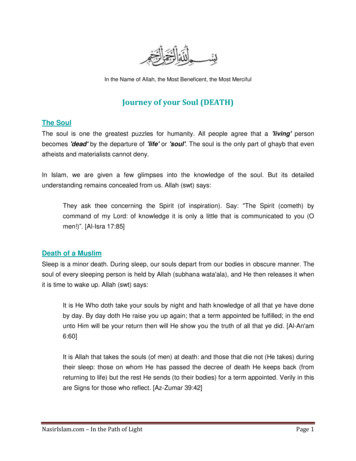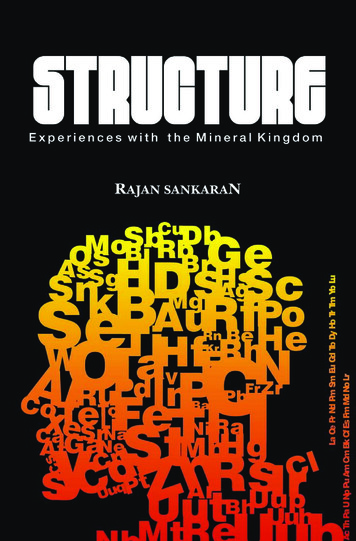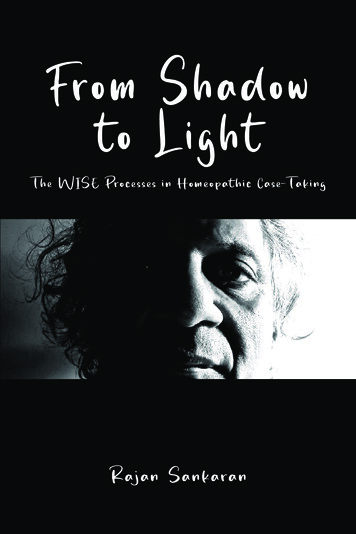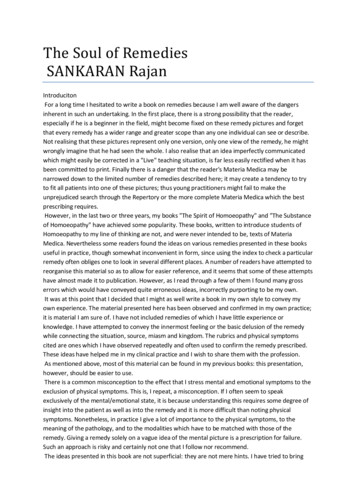
Transcription
The Soul of RemediesSANKARAN RajanIntroducitonFor a long time I hesitated to write a book on remedies because I am well aware of the dangersinherent in such an undertaking. In the first place, there is a strong possibility that the reader,especially if he is a beginner in the field, might become fixed on these remedy pictures and forgetthat every remedy has a wider range and greater scope than any one individual can see or describe.Not realising that these pictures represent only one version, only one view of the remedy, he mightwrongly imagine that he had seen the whole. I also realise that an idea imperfectly communicatedwhich might easily be corrected in a "Live" teaching situation, is far less easily rectified when it hasbeen committed to print. Finally there is a danger that the reader's Materia Medica may benarrowed down to the limited number of remedies described here; it may create a tendency to tryto fit all patients into one of these pictures; thus young practitioners might fail to make theunprejudiced search through the Repertory or the more complete Materia Medica which the bestprescribing requires.However, in the last two or three years, my books "The Spirit of Homoeopathy" and "The Substanceof Homoeopathy" have achieved some popularity. These books, written to introduce students ofHomoeopathy to my line of thinking are not, and were never intended to be, texts of MateriaMedica. Nevertheless some readers found the ideas on various remedies presented in these booksuseful in practice, though somewhat inconvenient in form, since using the index to check a particularremedy often obliges one to look in several different places. A number of readers have attempted toreorganise this material so as to allow for easier reference, and it seems that some of these attemptshave almost made it to publication. However, as I read through a few of them I found many grosserrors which would have conveyed quite erroneous ideas, incorrectly purporting to be my own.It was at this point that I decided that I might as well write a book in my own style to convey myown experience. The material presented here has been observed and confirmed in my own practice;it is material I am sure of. I have not included remedies of which I have little experience orknowledge. I have attempted to convey the innermost feeling or the basic delusion of the remedywhile connecting the situation, source, miasm and kingdom. The rubrics and physical symptomscited are ones which I have observed repeatedly and often used to confirm the remedy prescribed.These ideas have helped me in my clinical practice and I wish to share them with the profession.As mentioned above, most of this material can be found in my previous books: this presentation,however, should be easier to use.There is a common misconception to the effect that I stress mental and emotional symptoms to theexclusion of physical symptoms. This is, I repeat, a misconception. If I often seem to speakexclusively of the mental/emotional state, it is because understanding this requires some degree ofinsight into the patient as well as into the remedy and it is more difficult than noting physicalsymptoms. Nonetheless, in practice I give a lot of importance to the physical symptoms, to themeaning of the pathology, and to the modalities which have to be matched with those of theremedy. Giving a remedy solely on a vague idea of the mental picture is a prescription for failure.Such an approach is risky and certainly not one that I follow nor recommend.The ideas presented in this book are not superficial: they are not mere hints. I have tried to bring
out the innermost feelings of the remedy and it is not easy to discover these in patients other thanby artistic case-taking which delves deeply into such things as the patients delusions, dreams,hobbies, etc. What appears on the surface may be quite different from what is actually inside. Forexample, I had a case in which the expression was one of stage fright, but I observed that, in thatsituation, the patient's reaction, tremendous panic and fear, was as if he was about to be killed.My idea of understanding a remedy is to grasp the connection that ties together its myriadsymptoms: the basic delusion, its source (kingdom), the miasm to which it belongs, its symptoms - allmust be understood as aspects of a single whole if we are to even begin to truly understand aremedy. It is my attempt to trace out these connections that distinguishes this work from otherMateria Medicas. I believe, for example, that the "connecting link" in Sepia is the feeling that she isforced to do something against her intention. In the section on Sepia I try to show how this "link"connects every aspect of the remedy. This has been confirmed by me in practice time and again - Ido not believe it is mere theory. and yet the reader must remember that this is Rajan's experienceand not necessarily the final word.Similarly, the understanding of miasms presented here, for example, the theme of sycosis as being"fixed" is not traditional. It is merely my own understanding and someone else's view might well bedifferent. A complete discussion of my understanding of miasms is presented in "The Substance ofHomoeopathy" and is not reported here. In many cases I have described the "situation" of theremedy under discussion. Let me note here that the situation of the remedy is not necessarily theactual situation of the patient; it is rather the situation in which he (unconsciously) perceives himselfto be. Thus, when I say the Magnesium is an orphan, it means that the patient feels like an orphanthough he may, indeed, still have living parents. People set up situations according to theirperception of reality. Magnesium muriaticum, for example, feels that his friends will betray him andso avoids people. This only reinforces his feeling of being friendless.I wish to reiterate once again that a good Homoeopathic practitioner does not try to fit the patientto a particular remedy, but seeks first to clearly understand the patient and then to find theappropriate remedy through repertorization, the study of likely remedies in various Materia Medicasand review of the experiences of other homoeopaths with those remedies. Rather than trying to seewhat part of a considered remedy does fit the case, he must see what does not fit and must remainskeptical. The prescriber who would grow in skill must be able to recognise what does not fit andresist the tendency to "force" a fit. In this way he will be led to consider another remedy whichmight look similar but is not. This is what I try to do and if you do the same you may be able todevelop pictures of lesser known remedies.This book is meant for those who have read "The Spirit of Homoeopathy" and "The Substance ofHomoeopathy" because it is those earlier works that most fully express my understanding of theOrganon and Materia Medica. Without an understanding of my ideas on such things as case-taking,classification of remedies according to kingdom, miasms, etc., this book will not be of much benefit.This work may be used as an adjunct to the previous works but not as a substitute for them. Thereader who attempts to use this book without understanding the fundamental concepts may easilyfind himself lost without a compass.Finally let me repeat that the reader must bear in mind that this book is based on the experience ofone homoeopath amongst the multitude and should be taken as "notes along the way", not as thefinal word. Used in this way it may be of value.
acknowledgementI wish to acknowledge with gratitude the work done by Dr. Digish Doshi andDr. Rashmi Jaising. They are mainly responsible for painstakingly collecting the material from theearlier two books and putting it into its present form, after discussion with me regarding my ideas onthe remedy.I am grateful to Mr. Michael Zelnick who has gone through the text and put in finishing touches andMr. T.D. Anthony has been patient with us during the typing.NoteRubricsUsually from Synthetic Repertory.Occasionally from Complete Repertory.Where marked from Kent's RepertoryPhatakRefers to Phatak's Concise Repertory.There are also symptoms from Phatak's Materia Medica.The rubrics and symptoms mentioned at the end of the remedy are those I see as the main rubricsof the remedy and which I use for confirming the remedy.RemediesAconitum napellusAconitum napellus is a plant. The remedy prepared from it belongs to the acute miasm and is, infact, the most acute of all our remedies.The main feeling of Aconitum is of a sudden, intense threat from outside that comes suddenly andgoes suddenly. For that moment the person, who is otherwise calm becomes intensely restless,panicky and nervous. This feeling of a sudden threat is seen in the fear of walking across a busystreet, fear of accidents, of suffocation, in presentiment of death and in the delusion that he is aboutto die. Mentally this is expressed as a fear of death, anxiety and restlessness etc., while in thephysical sphere, we find a racing pulse, palpitation and flushing of face alternating with paleness,etc.Aconitum is excitable. The patient can flare up suddenly, can get frightened very easily. Pain candrive him beside himself and again this excitement will be manifested suddenly and violently, withgreat restlessness - an acute panic reaction.Great nervous excitability is the most important component of Aconitum. We must look for anexcitable person and not a calm one, if we are to prescribe Aconitum - one who cannot takeanything easy; everything excites him. Here it comes close to Nux vomica, Chamomilla, Staphisagria,Coffea and Graphites. But Aconitum is also very very restless. There is anxious restlessness. PierreSchmidt feels it is the most important remedy for anxious restlessness. Nux vomica, Staphisagria,Coffea or Ignatia are not so restless. Aconitum just can't sit still. He tosses about. This is similar toArsenicum and Rhus toxicodendron, it is only much more intense, vigorous, sudden and acute. It is asudden burst of excitement, fear or anxiety with great restlessness. He doesn't know where to go orwhat to do, his mind is ruled over by tremendous anxiety and fear. Then this whole state disappearsas suddenly as it had come without leaving a trace.Aconitum avoids crowds, crossing the street, indeed any other situation that would cause
excitement of mind. The proving reads: "Fear to go where there is any excitement". Sudden, intensefear from trivial causes is characteristic. It is not the insecure feeling of Calcarea or the terror ofStramonium nor the anxiety about health of Arsenicum, Nitric acid or Kali arsenicosum. It is anintense, sudden, panic state - something severe - the end, death! The rubric "Predicts the time ofdeath" is a combination of "Clairvoyance" with "Intense fear of death". But as I said earlier, this isnot the permanent state of Aconitum. Soon the excited state passes off and the normal state reemerges.But even in his normal state, Aconitum is hurried. As the proving reads: "He does everything in ahurry, runs about the house". His speech is hasty, jerky and excited: "Great impatience", "Wantsthings at once", "On attempting to think of one thing, another thought intrudes, this is soonsupplanted by another one and so on".Excitability can also make him cheerful, laughing, singing, dancing. But here too, the slightest triflecan change his cheerfulness to anxiety: "Alternate attacks of opposite states of humour"; "Fitfulmoods". It is this cheerfulness of Aconitum that differentiates it from Argentum nitricum andArsenicum. These phases of excitable cheerfulness are not seen in the later remedies.He can at times become very irritable, violent, intolerant of contradiction, shrieking, censorious butwill cool down soon. It is this sudden excitability that brings on such a state. There can also beepisodes of intense sadness which pass off soon, accompanied by the anguish, restless, moaning andgroaning of Aconitum.There are also sleep symptoms: somnambulism and talking in sleep. Dreams are anxious andclairvoyant. Sleep is anxious, restless, with constant tossing and turning, and starting in sleep.Aconitum is complementary to Sulphur.Physical concomitants are- Face expression, anxious, frightened.- Thirsty, burning.- Heat, palms.- Discolouration red cheeks.- Perspiration, uncovered parts, on.- Desires: beer, bitter drinks, acids.- Sleeps on back with hands under the head or sleeps in a sitting posture with head inclined forward,can't lie on sides.- Palpitation with great anxiety.- Face, red-hot.- Respiration oppressed.- Limbs feel weak.- Moaning, groaning, howling, loud whining or weeping;- Easily startled by noise.- Heat and discolouration, red, of face, in anxiety and excitement.Rubrics- Beside oneself, being.- Beside oneself, anxiety from.- Death, dying, feels as if.- Excitement, nervous.- Loquacity.- Mood, changeable.
- Speech, hasty.PhatakBesides himself, frantic, madness from pain.- AluminaAlumina is the oxide of the metal Aluminium. In the Periodic Table, Aluminium belongs to group IIIA and is associated with Boron (from which the remedy Borax is made). Alumina is one of thegreatest anti-syphilitic remedies along with Syphilinum, Aurum and Mercurius. In Syphilinum, thereis a total absence of hope which is one of the most essential things to the life of a human being.Phatak mentions: "Hopeless despair of recovery" - total hopelessness. Therefore Syphilinum is aremedy of death and destruction, he can be suicidal or homicidal. In Mercurius, the person'sindependence, another thing essential for life, has been taken away, and so he becomesrevolutionary, defiant, homicidal or suicidal. Then you have a need for acceptance in society, somereligious feelings; you take this away from man and you have Aurum - suicide again. In Alumina, theperson's identity or individuality has been taken away, and there is confusion.The Alumina person's identity has been so much suppressed that he doesn't know who he isanymore. He is so confused because someone has tried to shape him into something that he is not.It is one of the most important remedies for confusion of identity in our Materia Medica. Thesituation of Alumina may arise as for example from a conflict between parent and child, where thechild is not being given an identity. Whatever the child does, they say: "No, not this!" Hisindividuality and identity have been broken down. Whatever the child says is not right - "You are noone, you know nothing!" Then comes despair: "I don't know what to do. I don't know what I am,who I am. I don't even know what I want, what I want to be. I am so small, so timid and completelydependent on the parent."Alumina is listed under the rubrics: "Irresolution, timidity and fear", "Delusion, head belongs toanother". The patient doesn't even know to whom his head belongs. He feels as if somebody elsethinks for him, and he can't think for himself. He feels as if someone else heard or said somethingwhen it was he who heard or said it. His real identity is being suppressed, is being pushed in, so thathe has to mould himself according to what other people want. Sometimes the parental control is sostrong that the child loses his identity and becomes impulsive, for example he may grab someone'shand, or has impulsive acts of violence. In failed cases of Alumina, there is a tremendous sense ofdesperation to the extent of suicidal tendencies: "Morbid impulses to shoot himself", "Impulse tocut herself even though she abhors the idea". This shows the impulsiveness, the destructiveness,irresolution, timidity and fear.Control is a big theme in Alumina. A lot of his problems have to do with control - control of thebody, of the limbs, impulses, a fear of losing control. As the mental will has been undermined(symptom: "Weak will"), so also the will is taken away from the muscles too, and he can't moveproperly, he has no balance. At the same time, Alumina likes to be in control of situations. Being amineral, there is also an element of organization, of fastidiousness. A man who has lost his identityhas to be fastidious, has to do everything perfectly according to someone else, otherwise he feelscompletely humiliated and finished.He feels he needs to be hard and rigid in order to keep up his identity, thus in the coped-up statethe Alumina-patient can be quite hard and rigid.Hence the rubrics:- Timidity alternating with assurance.- Obstinate, resists the wishes of others.
- Defiant.One case of Alumina that I remember well is that of a patient who spoke of himself as if speaking ofan object, or as if he were reading a weather report. He sounded detached hardly ever using thepersonal pronouns "I" and "My". For example he said: "The itching sensation was almost wild. Itbecame a permanent feature on the face. There was a lot of sticky fluid on scratching. It appearedand the face became bright red. It is worse from sunlight." He also argued a lot, almost endlessly, asif to establish his own identity by arguing. When someone needs to argue endlessly, it is only tocreate and maintain the identity he does not feel he possesses.Alumina might be a good remedy for left-handed children who have been forced to write with theirright hand. They are forced to lose their identity and become confused as to whether they are lefthanded or right-handed. When you force a child to be something other than what he naturally is,you encourage the Alumina situation.Rubrics- Confusion, identity, as to his.- Delusion, head belongs to another.- Delusion, identity, errors of personal.- Contradictory to speech, intentions are.- Impulse, morbid.- Suicidal disposition, seeing blood or a knife, she has horrid thoughts of killing herself, though sheabhors the idea.- Fastidious.- Ailments, scorn, being scorned.- Contemptuous.- Obstinate, resists wishes of others.Kent- Choking, oesophagus, swallowing.Phatak- Fear, impulse, of his own.- Soles soft, furry.- Talks, through him, other person, as if.Ambra griseaAmbra grisea is an animal remedy. It belongs to the sycotic miasm.Like other animal remedies it has the quality of divided will. It has two wills and has a kind ofcontempt for self. It also has traits such as animation, loquacity, sexuality, playfulness, love ofanimals, etc.It is a sycotic remedy; an Ambra grisea woman feels that something is wrong with her that needs tobe covered up. There is an intensely dirty feeling about herself. The expression "I feel like shit" aptlydescribes the main feeling of Ambra. The feeling is that something in her is intensely disgusting andthat this part should never be exposed or she will be completely forsaken. Ambra feels atremendous sense of embarrassment. Other remedies like Silicea, Carbo vegetabilis, Plumbum,Gelsemium, etc., also have something of this feeling, but Ambra feels it intensely and is acutelyconscious of the slightest thing she does. This embarrassment is more when it comes to personalhabits like passing stool and urine.The symptom of Ambra: "Cannot pass stool in presence of others" describes this feeling exactly as ifto say that "this disgusting part in me should never be revealed to others or they will consider me
disgusting". This symptom means that the patient cannot even have somebody in the next roomwhen he is passing stool. It means that the sounds that he makes in the toilet embarrass him somuch that he cannot bear the thought of somebody standing even in the next room. He would liketo clear the whole house before he passes stool, to see that there is nobody around. This is thenature and degree of embarrassment in Ambra. Indeed, he cannot even bear the thought of going tosomebody else's house, afraid he may get an urge for stool. When he gets the urge for stool, he getsanxious: "Anxiety with ineffectual urging for stool". This is a form of anticipatory anxiety in Ambragrisea.This feeling of embarrassment creates tremendous shyness in company and in the presence ofstrangers. Because of its symptoms "Bashful" and "Strangers, in presence of " it comes quite close toBaryta carbonica. But Ambra has this very acute feeling of embarrassment which Baryta carbonicadoesn't have; Baryta carbonica has a tremendous irresolution which represents the feeling of lack ofcapability, which is not seen in Ambra.Young girls with this Ambra feeling, in their embarrassment can talk in a flitting, flighty manner.They can also become mischievous and play pranks that are very much in keeping with this theme ofshame and shamelessness. Embarrassment about one's own body is one of the main themes. Alsothere is a feeling of embarrassment after doing something she considers disgusting or shameful.Among other symptoms of Ambra I have noted: "Fear of night" and fear "As if diabolical faces crowdupon her to swallow her". I have also noted in Ambra a love for whales.Rubrics- Anxiety, company, when in.- Anxiety stool before, ineffectual desire for, from.- Company, aversion to, presence of other people agg. symptoms, desire for solitude.- Company, aversion to, presence of people intolerable to her during stool.- Delusion, faces sees, diabolical around, upon him.- Delusion, faces sees, hideous.- Fear, strangers of.- Timidity, bashful.- Timidity, company in.Phatak- Modern society girls.- Strangers, presence of, aggravates.- Embarrassement aggravates.Anacardium orientaleAnacardium Orientale is a plant. The remedy belongs to the cancer miasm.The situation of Anacardium is that of a kind of child abuse. Overstrict parents impose all theirdesires on the child and do not allow him to think or do anything on his own. He cannot take his owndecisions, to the extent that he is not allowed even to decide what clothes he should wear. If hestarts taking his own decisions or does not live up to the expectations placed upon him, he will bepunished cruelly. So he tries to live up to these expectations by being obedient and angelic in hisbehaviour, and by being excellent in his work. But he begins to develop a lack of self-confidence, andbecomes nervous. He is irresolute, because the outcome of his decisiveness is usually a severepunishment. If the domination persists and he is compelled to put up with it, he starts reacting withcruelty, malice, want of moral feeling, and antisocial behaviour. Here he may also develop atremendous overconfidence with contempt for others. But Anacardium can be very hard and cruel,
and at the same time have a lack of self-confidence.There are thus two sides to Anacardium. On the one hand he is good, angelic, obedient from fear ofpunishment. He is very orderly, fastidious, cannot rest till things are in proper place. The other partof him is hard, malicious, violent, devilish, disgusted with himself. He becomes immoral, developssuicidal or homicidal tendencies, is abusive, stubborn and avoids the company of people. These twosides of Anacardium are constantly in opposition to each other: should he be an angel or a devil.Anacardium could be the wife of a selfish tyrant who rules with an iron fist, and does not allow herto take any decisions. She becomes irresolute, lacks in self-confidence, is confused - always has twowills. She becomes dull and very absent-minded (Anacardium has a marked absent-mindedness).She may be childish, idiotic and timid out of lack of self-confidence and fear. The fear can paralyseher thinking as can be seen when appearing for an examination.Whereas Anacardium is known for its hard-heartedness, cruelty, want of moral feeling, acompensated Anacardium cannot be cruel even when the situation demands. He will, perhaps, beunable to kill even an irritating mosquito.Thus, Anacardium has the feeling of an angel sitting on one shoulder, and a devil on the other.Kent- Will, contradiction of, two wills, feels, as if he had.- Delusion, that he is separated from the world.- Unfeeling, hard-hearted.- Delusion, of being double.- Delusion, is under super-human control.- Delusion, sees devils.- Cruelty, inhumanity.- Cursing.- Hatred.- Moral feeling, want of.- Kill, desire to.- Kisses his companions hands.- Confidence, want of self.- Timidity, bashful.- Rage, leading to violent deeds.Phatak- Antagonism with self.Anhalonium lewiniiAnhalonium is a "drug" remedy. It is prepared from Peyotl the cactus from which mescaline isextracted. It belongs to the cancer miasm.The experience of mescaline is often one of merging with one's surroundings or the feeling of beingone with the whole of existence, seeing oneself without any boundaries. This is close to the highestspiritual experience as described in Hindu or Buddhist philosophy as oneness or non-duality of Spirit.This experience implies immortality - what dies is the body; as the Self is continuous with the wholeof existence, it cannot be mortal.The need for such an experience arises from the feeling of having no roots, of having no identity, offeeling totally isolated and separated from other human beings, so that one sees one's ego as beingseparate and being totally mortal. This can create immense fear of losing one's very existence whichis much more than the mere fear of death.
The easiest way to experience this loss of existence is for a person to ask himself the question:"Who am I, if I remove my name?" Just imagine that you don't have a name and you are not allowedto invent a name for yourself and ask: "Who am I?" There is a tremendous blankness, a void, anemptiness which is very scary. A void which the patient tries to bridge by connecting himself to notonly his name, but also to some group or society, his family, etc., so that he extends himself beyondbody and his larger group identity does not die so easily.Anhalonium comes from a situation where people experience a total solitude and feel they couldlose their identity. In such a situation the only solution is being in the Anhalonium state, where theycan identify themselves with not only a group or family but with the whole of existence.I believe that many a well-known spiritual leader/teacher could have had a background of isolationand an absence of roots, which could be a powerful impetus to seek one' spiritual identity.Anhalonium belongs to the cancer miasm, where the person has to stretch much beyond himself orhe will lose his existence. He starts living inside a bubble, isolated from the rest of the world butinside it, he creates his own universe.Anhalonium people speak in terms of universe, space, etc. They have the most fantastic experienceswhich are often spiritual, and have no fear of losing their ego, identity or losing a dear person.Often, I have found that they had tried out drugs and had good experiences with mescaline. Theyoften try their best to belong to groups but usually feel quite alone. They also react well to musicand can go into trance from rhythms.Rubrics- Confusion, identity, as to his, depersonalization, loss of self-knowledge and self-control;disassociation from or self-identification with environment, personal disruption.- Decomposition, space, of.- Delusion, immortality, of.- Delusion, standing by oneself.- Environmental orientation increased.- Forsaken, isolation, sensation of.- Merging of self with one's environment.- Reality, flight from.Antimonium crudumAntimony is a metal which lies in the periodic table, between Arsenic and Bismuth. The remedies ofthe group Phosphorus, Arsenicum, Antimonium and Bismuthum shut out or exclude others andisolate themselves.Phosphorus feels that he is not getting enough attention and feels secure only when amongst a lotof friends, receiving a lot of attention and love. Arsenicum views the world as threatening and feelsisolated and insecure; he feels secure in the company of only a few. Antimonium feels that he hasbeen disappointed and needs to isolate himself; he feels secure in the company of still fewer people.Bismuth feels very alone and will be secure in the company of only one person, i.e. the mother.Antimonium crudum is the sulphide of antimony. In it, we see the Antimonium feeling of being letdown and disappointed by others, and therefore the need to narrow one's circle, to isolate oneself.Also present are the Sulphur symptoms of theorizing and fantasizing. These combine to makeAntimonium crudum a person who has narrowed himself down, and who starts fantasizing.The patient finds the world around him so disappointing that he simply shuts it out, and conjures upan illusionary, ideal world that he starts living in. He longs for that which he misses or has beendisappointed by: he becomes nostalgic and longs for the past, for his native land, for the ideal
woman - the woman of his dreams. He becomes poetic and sentimental. Poetry often expresses hisinner wishes. He is lost in this idealization. It differs from Cannabis indica or other drug remedies,because he does not create a fantasy, but only longs for and creates his ideal and becomes verysentimental. Whereas Cannabis indica fantasizes, Antimonium crudum idealizes. Antimoniumcrudum's idea is a perfection of the real, perhaps practically impossible, but fundamentally realitybased. The fantasies of the "drug group" of remedies, on the other hand, are fundamentally not ofthis world to begin with. For example he may be disappointed in love and then projects all hisidealizations onto another woman, she becomes his dream girl. He does not want to face the realityof things because reality is so disappointing that he could become suicidal. He becomes dull, doesnot want to be touched or approached, does not want to be looked at or spoken to, does not likeany attention. He is fond of solitude, and especially likes to be by himself in the moonlight.The physical symptoms are the desire to overeat, and the aggravation from the same. It also hasailments from vaccination.Rubrics- Ailments from love, disappointed.- Sentimental in the moonlight.- Verses makes.- Fancies, exaltation, of.- Looked at, cannot bear to be.- Anger when touched.- Suicidal disposition.- Dre
SANKARAN Rajan Introduciton For a long time I hesitated to write a book on remedies because I am well aware of the dangers inherent in such an undertaking. In the first place, there is a strong possibility that the reader, especially if he is a beginner in the field, might become fixed on these remedy pictures and forget


